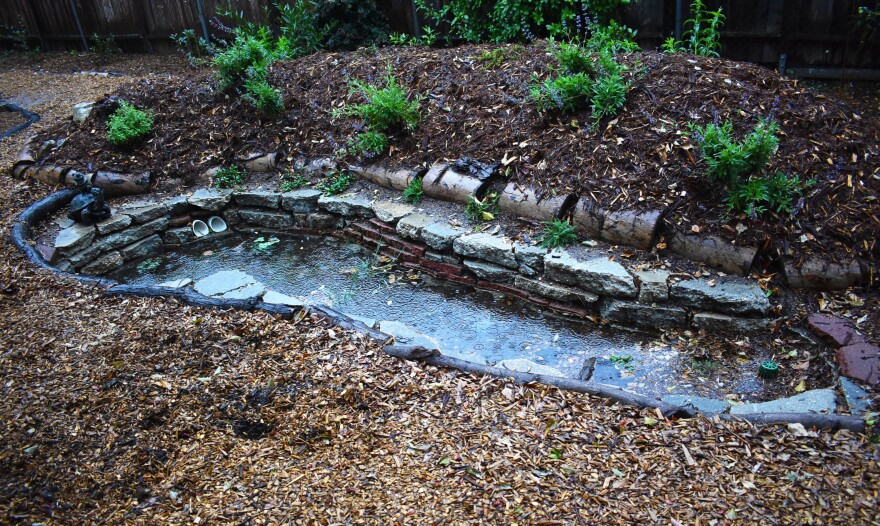Truth matters. Community matters. Your support makes both possible. LAist is one of the few places where news remains independent and free from political and corporate influence. Stand up for truth and for LAist. Make your year-end tax-deductible gift now.
How You Can Help Refill LA's Aquifers By Capturing Stormwater At Home

Recently, we dove deep on how every time rain falls in Southern California, gigantic pieces of infrastructure come to life in an effort to sequester as much of the stormwater as possible.

Water agencies implement dry wells, dams and spreading grounds the size of neighborhoods to give each drop a chance to percolate deep into the soil and refill our overdrawn reservoirs.
The problem is we've all but run out of room for spreading grounds, and while the water agencies are implementing other options, you can make a difference at the household level as well.
All you need is a shovel, some rocks and a tiny patch of land.
How you can capture stormwater on your property
The goal is simple: you want to slow down water and give it a chance to sink into the earth.

Landscape design firm Studio Petrichor in Altadena often features swales (bougie trenches) in their plans, incorporating rocks to prevent erosion and native plants that are able to take the inundation. They fill them by rerouting water from the street and downspouts.

Here's are some recommendations from the design firm :

- Consult a professional and make sure that you aren't in a liquefaction or landslide zone as you don't want to compromise the integrity of the soil your home is sitting on. As we've learned in recent months, water can work itself between layers of soil and keep them from sticking together, leading to catastrophic failure.
- Pay attention to how water is moving across your property and whether you can reroute and intercept it, potentially from downspouts. If it's moving toward your foundation, it'll be difficult to capture unless you install drainage to move it elsewhere.
- Once you identify a spot, dig a smooth depression. Reinforce the sides with rocks and mulch the bottom. You can also plant plants that can take being flooded.
- Studio Petrichor also prioritizes installing hügelkultur berms — or piles of logs beneath mulch/soil — which help to hold on to water and add organic matter to the earth as they break down over time.
- Make sure that if your rain garden overfills, you've figured out a way to safely route the water into the street where it can make its way to a storm drain. The firm sometimes installs multiple connected swales on their client's properties, which begins to fill as the one before it spills over.
If you're in the city of L.A., you should know that it's now required that many design plans have some sort of stormwater remediation. So, you could also follow their guidelines, which you can download here.
How big of a difference can our yards make?
It's tough to quantify how much any one yard will contribute to an aquifer, but according to analysis done for LADWP's Stormwater Capture Master Plan released in 2015, if widely implemented, water catchment features could have an impact.
"Parcel by parcel there is an additive effect and we've shown qualitatively that additive effect is really significant," said Edith de Guzman, water equity and adaptation policy cooperative extension specialist at UCLA.
The master plan was prepared with Tree People, which de Guzman was with at the time.
It depends on how you slice it, but according to de Guzman, if you add together all the small distributed projects possible (swales, rain gardens, permeable pavement) on everything from commercial properties to those with single family homes, we could theoretically add an additional 110,000 acres of land to our water percolation portfolio.
That could mean anywhere from 88,000 to 165,000 more acre feet could be sent down into our aquifers, which could potentially supply between 350,000 and 660,000 households for a year.
This is all theoretical and comes with a ton of caveats — Is the area too polluted? Is the soil conducive to infiltration and can it be dug safely? — but it gives us a rough idea of what's possible.
“It depends on location. In many portions of the San Fernando Valley, not only are the soils appropriate for doing infiltration, but so is the proximity to the underlying groundwater aquifer. In other parts where there's clay soils or there aren't necessarily connections to the aquifer," de Guzman said. "It doesn't make as much sense.”

Not good for every property
You may not want to install water catchment features if you have dense clay soil that doesn't drain, or if you're in a landslide or liquefaction zone, and standing water could raise the risk of a catastrophic event.
While each property needs to be independently assessed, you can take a quick glance at this map from the master plan:

According to LADWP, the soil found in categories A and B should allow the best infiltration (made up of sand and silt as well as clay) and are located over important aquifers. If you're in category C, it doesn't mean that you shouldn't try and capture water, however, you may run into issues. Check out page 27 for a closer look.
If you want to store water on your property, cisterns are also an option.

An L.A. stormwater capture success story
Take inspiration from the Elmer Avenue Neighborhood Retrofit that we profiled last year.

The San Fernando Valley neighborhood used to flood miserably. Now, after incorporating permeable pavement, curb cuts and vegetated bioswales, not only has flooding been attenuated, but the area's been beautified by all the greenery.









